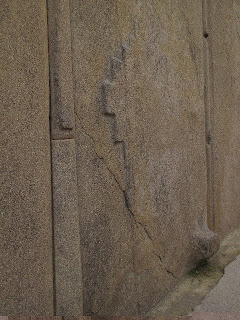Our first stop in Ollantaytambo was all about shopping. In return for intruding on their turf, the rural folks appreciate a bit of an incentive. Instead of just handing out money (which may be spent on less healthy treats like candy, alcohol, cigarettes, etc.) many tourists have made the switch to handing out wholesome goods ranging from bread and fruit to pencils and notebooks. We walked through town and picked up bags of coca leaves to share with the grownups and bread and pencils to give to the kids.
Once we had our booty ready to distribute we drove up a narrow, cratered dirt road for forty minutes past enormous cliff faces dropping thousands of feet to the valley floor. Bit by bit the trees began to thin and finally disappeared as we passed above 12,000 feet. We had arrived in the small town of Patacancha.

Patacancha is a village where the traditional way of life is "preserved" (insofar as this is actually possible in this age of ubiquitous internet access and cell phones...) through tourism and international grants that help the local people sell their weaving to a global clientele. As soon as we stepped off the bus, men and women in brightly colored clothing began to shuffle towards us with heavy lliqlas full of their work suspended on their shoulders. It was business time in Patacancha.
We made our way down into a courtyard where a group of five women, most with their children at their side, had spread out a selection of hats, belts, capes, skirts, vests, shawls and dolls for us to buy. There were two men who set up apart from the women and had only blankets and belts for sale. My brother and I shared coca leaves with the men while Sophia and Isabel played with the local children, distributing pencils to them and tying on their hats. I too took a hat for a trial run as evidenced in the photo below. Krista was helping my mom bargain in Quechua and we all eventually bought some really beautiful weavings.



Heading back toward Ollantaytambo we came to the town of Huilloq, which has a warehouse built by an NGO for the display and sale of textiles. This was a larger town than Patacancha and there were a lot of kids following us around to get bread and pencils. We actually burned through all 30 loaves in about ten minutes. I asked the kids about their school and was happy to hear that they enjoyed it and that they were learning in both Spanish an Quechua. Some of the smaller kids were fascinated with Sophia and Isabel and wouldn't leave their sides.

It was sobering to see how some of the children were barefoot, walking through the muddy dirt paths with filthy clothing and filthy faces. On the other hand, it was amazing to see how that didn't really make any difference to Sophia and Isabel. Kids are kids, and they all had a really nice time talking and playing together despite the vast differences between their lives. 

We stopped in a pull-off on the narrow road where Ronald and Erica feverishly set up a picnic table and brought out platter after platter of amazing food for our picnic lunch. The quality of the setting was commensurate with that of the food and there was so much of it that we couldn't come close to finishing it. We stopped campesinos who were walking by to offer them fruit and bread to carry back to their houses. David also shared some coca with a woman who was so excited to get some.


After packing up our lunch and getting back in the van we continued back down the valley toward the ruins of Ollantaytambo. The walls of the valley were striking in the late afternoon light.
The ruins of Ollantaytambo are squeezed into a tight drainage on the south side of a small, but steep mountain. There are terraces climbing up to a temple with commanding views of the valley below in every direction. The stones used to build this temple are impossibly large. They were quarried 12 kilometers from the construction site and then transported here (how exactly they were moved is still up for debate) and assembled with such skill that you could not pass a piece of paper between the mortarless joints. Someone told us that the Inca used this particular pink granite because of its high quartz content. Quartz crystals were prized for their "energy content" and so were a perfect choice for the walls of the Temple of the Sun. Whether or not you believe this, the visual impact is breathtaking.
The path from the Temple of the sun across the sheer face of the mountain to another set of terraces was airy, to say the least. We began our descent to the river as the sun sank behind the ridges defining the valley. We walked along the elaborate irrigation canals laid out on the valley floor on the way to the van.
The day was honestly mind boggling, almost too much to take in in such a short time. On the drive back we could see big storm clouds over Cusco to the south and we were very thankful that we happened to be where the rain wasn't on this long and extraordinary day.










No comments:
Post a Comment